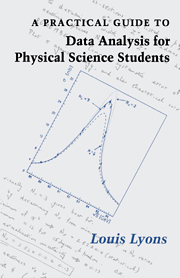Book contents
- Frontmatter
- Contents
- Preface
- Glossary and Conventions
- 1 Experimental errors
- 2 Least squares fitting
- Appendix 1 Useful formulae
- Appendix 2 Partial differentiation
- Appendix 3 The binomial distribution
- Appendix 4 The Poisson distribution
- Appendix 5 Student's t distribution
- Appendix 6 Statistical tables
- Appendix 7 Random numbers
- Index
- Frontmatter
- Contents
- Preface
- Glossary and Conventions
- 1 Experimental errors
- 2 Least squares fitting
- Appendix 1 Useful formulae
- Appendix 2 Partial differentiation
- Appendix 3 The binomial distribution
- Appendix 4 The Poisson distribution
- Appendix 5 Student's t distribution
- Appendix 6 Statistical tables
- Appendix 7 Random numbers
- Index
Summary
Why estimate errors?
When performing experiments at school, we usually considered that the job was over once we obtained a numerical value for the quantity we were trying to measure. At university, and even more so in everyday situations in the laboratory, we are concerned not only with the answer but also with its accuracy. This accuracy is expressed by quoting an experimental error on the quantity of interest. Thus a determination of the acceleration due to gravity in our laboratory might yield an answer
g = (9.70 ± 0.15) m/s2.
In Section 1.4, we will say more specifically what we mean by the error of ±0.15. At this stage it is sufficient to state that the more accurate the experiment the smaller the error; and that the numerical value of the error gives an indication of how far from the true answer this particular experiment may be.
The reason we are so insistent on every measurement including an error estimate is as follows. Scientists are rarely interested in measurement for its own sake, but more often will use it to test a theory, to compare with other experiments measuring the same quantity, to use this parameter to help predict the result of a different experiment, and so on. Then the numerical value of the error becomes crucial in the interpretation of the result.
- Type
- Chapter
- Information
- Publisher: Cambridge University PressPrint publication year: 1991
- 1
- Cited by



